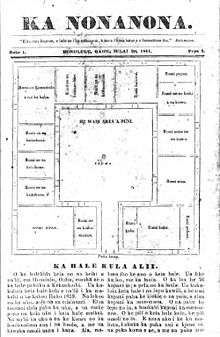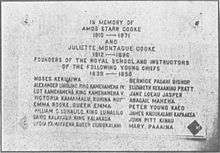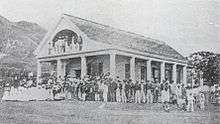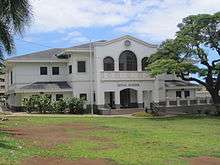Royal School (Hawaii)

The Royal School is a historic school founded in 1839 in Honolulu, Hawaiʻi, as the Chiefs' Children's School. The school was renamed as the Royal School in 1846. After the boarding closed in 1850, it became a day school for children. It later became a public elementary school, and moved to its present campus in 1967.
The present Royal Elementary School continues to educate children from kindergarten to Grade 5 and has been named a Blue Ribbon School several times.[1]
History
The Chiefs' Children's School was founded by King Kamehameha III of the Kingdom of Hawaii as a boarding school to educate the children of the Hawaiian royalty (aliʻi). The school was first located where the ʻIolani Barracks stand now. The need for the school was agreed upon during the general meeting of the mission in June 1839. The buildings were ready by 1840, and two more students were added in 1842.[2]
Elizabeth Kekaʻaniau claimed that the King chose fourteen of the children personally, excluding the last two alumni John William Pitt Kīnaʻu and Mary Polly Paʻaʻāina.[3] Although an 1844 article in the Polynesian listed all children with the exception of Kīnaʻu, who had just enrolled, as "princes and chiefs eligible to rulers."[4] No school in Hawaii has ever produced so many Hawaiian leaders in one generation.
The main goal of this school was to raise the next generation of Hawaiian royalty to become Christian rulers. Seven families that were eligible under succession laws stated in the 1840 Constitution of the Kingdom of Hawaii and that had converted to Christianity, who were Kamehameha's closest relatives, made up the majority of the school. They were:

- From the sister of Kamehameha III: Kīnaʻu's children, Lot, Victoria Kamāmalu, Moses Kekuaiwa and Alexander Liholiho;
- From his half-brother Pauli Kaʻōleiokū's great granddaughter and great-great grandson: Bernice Pauahi and John William Pitt Kīnaʻu;
- From his father's younger brother, Keliʻimaikaʻi: his great-great granddaughter, Emma Naʻea and great great grandson, Peter Young Kaʻeo;
- From the younger brother of his father, Kalaimamahu: his great grandson, William Charles Lunalilo;
- From his father's eldest brother, Kalokuokamaile: his great granddaughter, Elizabeth Kekaʻaniau Laʻanui;
- From his grandfather's cousin, a direct line from one of the royal twins, Kameʻeiamoku's great great grandchildren: David Kalākaua, Lydia Kamakaeha and James Kaliokalani;
- Also from his grandfather's cousin, Kahekili, daughters of Liliha with Kalaniulumoku: Jane Loeau; and with Namaile: Abigail Maheha.[5]
It was run by Amos Starr Cooke and Juliette Montague Cooke from the American Board of Commissioners for Foreign Missions.[6] It was a long, two story frame building with a large dining room and separate sleeping quarters for the children and for the Cooke family. There was also the New England parlor, furnished with handmade and treasured furniture sent from home, and with much brought from China. It resembled nothing Hawaiian in its appearance nor its atmosphere. The royal children were taught how to act like Americans and to speak like Americans. The Hawaiian kahu (traditional caretaker of children) John Papa ʻĪʻī was selected as assistant teacher.[2]:291
In 1846 the Kingdom government took over funding of the school under the Minister of Public Instruction Richard Armstrong and the school was renamed the "Royal School".[7] By 1848 the school declined as the children graduated or married. For example, Moses left school in 1847 to live with his father and died in the 1848 measles epidemic. Jane married Mr. Jasper. Missionary children were also allowed to attend in 1849. It was moved to its present location in 1850 and became a day school instead of a boarding school for the general public. The next principal was Edward Griffin Beckwith (1826–1909) until he became president of Oahu College (now Punahou School) in 1854. In 1853 it had 121 students, of which 8 were pure Hawaiian and 18 part Hawaiian.[8]


It is now a public elementary school, Royal Elementary School, the oldest school on the island of Oʻahu. It serves grades K-5 and is located at 1519 Queen Emma Street, coordinates 21°18′42″N 157°51′13″W / 21.31167°N 157.85361°WCoordinates: 21°18′42″N 157°51′13″W / 21.31167°N 157.85361°W.[9] A sculpture by Kim Duffett "Mai ka Hina Kua a ka Hina Alo" was added in 2005. It was partially funded by a foundation named for the Cooke Family.[10]
It is not to be confused with Punahou School, which was also founded by Protestant missionaries, but for their own children in 1841.
Alumni
Ruling alumni
- Queen Liliuokalani
- Queen Emma, wife of Kamehameha IV
- King David Kalākaua
- King Kamehameha IV
- King Kamehameha V
- Princess Victoria Kamāmalu
- King William Charles Lunalilo
Aliʻi alumni
- Aliʻi Bernice Pauahi Bishop
- Aliʻi Abigail Maheha
- Aliʻi Mary Polly Paʻaʻāina
- Aliʻi Peter Young Kaʻeo
- Aliʻi Elizabeth Kekaʻaniau Pratt
- Prince Moses Kekūāiwa
- Prince John William Pitt Kīnaʻu
- Ali'i James Kaliokalani
Aliʻi alumni as day school
- Gideon Kailipalaki Laanui
- Nancy Sumner
- Jane Swinton
- Martha Swinton
- Julia Moemalie
- Mary Ann Kiliwehi
- John Mahiʻai Kāneakua
- David Kawānanakoa
- Edward Abnel Keliʻiahonui
- Jonah Kūhiō Kalanianaʻole
- Kaʻiulani
References
- ↑ "Momilani, Royal and Ewa Beach elementary named Blue Ribbon Schools". The Honolulu Advertiser. November 13, 2009.
- 1 2 Sheldon Dibble (1843). History of the Sandwich Islands. Lahainaluna: Press of the Mission Seminary. p. 289.
- ↑ Pratt, Elizabeth Kekaaniauokalani Kalaninuiohilaukapu (2009) [1920]. Daniel Logan, ed. History of Keoua Kalanikupuapa-i-nui: Father of Hawaii Kings, and His Descendants. Honolulu: republished by Kessinger Publishing. pp. 52–55. ISBN 978-1-104-76661-0.
- ↑ "Died". The Polynesian. July 20, 1844.
- ↑ "The Royal School". Hawaii's Royal Family web site. Keali'i Pubs. Retrieved 2010-01-22.
- ↑ Orramel Hinckley Gulick (1918). The pilgrims of Hawaii: their own story of their pilgrimage from New England. Fleming H. Revell company. pp. 56–57.
- ↑ Allen, Helena G. (1982). The Betrayal of Liliuokalani: Last Queen of Hawaii, 1838-1917. Glendale, CA: A. H. Clark Company. p. 52. ISBN 978-0-87062-144-4. OCLC 9576325.
- ↑ Ralph Simpson Kuykendall (1965) [1938]. Hawaiian Kingdom 1778-1854, foundation and transformation. 1. University of Hawaii Press. p. 362. ISBN 0-87022-431-X.
- ↑ "Royal School". official web site. Hawaii Department of Education. Retrieved 2009-10-03.
- ↑ "Royal School sculpture honors passing of knowledge". Honolulu Advertiser. May 17, 2005.
External links
Further reading
- Amos Starr Cooke and Juliette Montague Cooke (1970). Mary Atherton Richards, ed. The Hawaiian Chiefs' Children's School: a record compiled from the diary and letters of Amos Starr Cooke and Juliette Montague Cooke by their granddaughter. C. E. Tuttle Co.